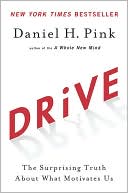| TRANSFORMING LEADERSHIP | |
| BY DEVELOPING GREAT LEADERS |

|
|
|
| THE PLAN - LEAD - EXCEL LETTER |
| Newsletter Home | Bob's Thoughts | Guest Column | Review | Newsletter Archives | Plan-Lead-Excel Home |
|
|

|
THE REVIEW |
Drive: The Surprising Truth About What Motivates Us - A Review by Daniel H. Pink | |
|
I am constantly amazed at new "discoveries" that money and reward are not as effective as fueling an individual's internal need for a feeling of accomplishment. Alas, these discoveries keep coming. In Drive: The SurprisingTruth About What Motivates Us, Daniel H. Pink makes yet another attempt to help people understand this critical point. The idea of motivating people by offering rewards has been at the forefront of much management theory. In a nod to the computer age, Pink calls this Motivation 2.0, the operating system of most organizations. This carrot and stick approach doesn't work well in today's organizations, though I would contend it never really did. True motivation is an internal force, and is seldom something that can be accomplished with external rewards and punishments. Enter Motivation 3.0. The Motivation 3.0 operating system works on the idea that humans are driven to learn, create, and better the world. Therefore, they will work best when they have the opportunity to realize these internal motivators. A few companies, such as Atlassian, 3M, Google, and Best Buy have realized this, creating climates that allow and even encourage employees to accomplish tasks because it satisfies their internal drive. These companies have changed their policies to concentrate on results, with a much less structured environment that allows employees to come and go as they please, as long as they produce results within the required timeframe. Such a management concept requires some pretty big changes to previous practices, but at these companies at least, it has worked. First there was Douglas McGregor with Type X and Type Y descriptions of human behavior. Now Pink gives us Type X and Type I. His Type X behavior, similar to McGregor's, indicates extrinsic motivation and is the common form of Motivation 2.0. Conversely, Type I behavior is fueled by intrinsic desires, the satisfaction of the activity itself, and is at the heart of Motivation 3.0. Type I behavior requires three elements. The first is autonomy over task, time, team, and technique. The second, mastery, is an element that is impossible to fully realize and is at once frustrating and alluring. The third is purpose. Quite simply, humans respond best when they have a real reason for doing what they're doing. Purpose provides the balance for autonomy and mastery. Pink briefly mentions that there are times when the old methods are still appropriate, such as more mundane repetitive work. In these cases he suggests that workers are given a rationale for why the work is necessary, an acknowledgement that the work is boring, and autonomy over how they complete the task. This doesn't take into account those people, and there are some in the workplace, who just don't respond well to the Motivation 3.0 environment. For the more enlightened leaders, Drive will be a rehash of things they already know. But it's a good review and provides some very good research as well as interesting and current examples. For most leaders though, Pink's ideas will seem almost subversive. These are the people who need to carefully study this book because these ideas are not subversive, or radical, or even all that revolutionary. Maybe, in time, everyone will look at the information in this book and say, "Yea, I already knew that." |
Follow Me! | |
| RLM PLANNING AND
LEADERSHIP PO Box 50984 Albuquerque, NM 87181-0984 866-243-1682 www.planleadexcel.com email rlm@planleadexcel.com PLAN - LEAD - EXCEL | |